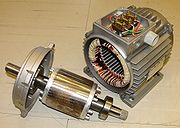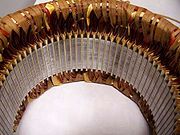
Stator
Encyclopedia


Rotordynamics
Rotordynamics is a specialized branch of applied mechanics concerned with the behavior and diagnosis of rotating structures. It is commonly used to analyze the behavior of structures ranging from jet engines and steam turbines to auto engines and computer disk storage...
system, found in an electric generator, electric motor
Electric motor
An electric motor converts electrical energy into mechanical energy.Most electric motors operate through the interaction of magnetic fields and current-carrying conductors to generate force...
and biological rotors
Flagellum
A flagellum is a tail-like projection that protrudes from the cell body of certain prokaryotic and eukaryotic cells, and plays the dual role of locomotion and sense organ, being sensitive to chemicals and temperatures outside the cell. There are some notable differences between prokaryotic and...
.
Depending on the configuration of a spinning electromotive device the stator may act as the field magnet, interacting with the armature
Armature (electrical engineering)
In electrical engineering, an armature generally refers to one of the two principal electrical components of an electromechanical machine–generally in a motor or generator, but it may also mean the pole piece of a permanent magnet or electromagnet, or the moving iron part of a solenoid or relay....
to create motion, or it may act as the armature, receiving its influence from moving field coils on the rotor
Rotor (electric)
The rotor is the non-stationary part of a rotary electric motor, electric generator or alternator, which rotates because the wires and magnetic field of the motor are arranged so that a torque is developed about the rotor's axis. In some designs, the rotor can act to serve as the motor's armature,...
.
The first DC
Direct current
Direct current is the unidirectional flow of electric charge. Direct current is produced by such sources as batteries, thermocouples, solar cells, and commutator-type electric machines of the dynamo type. Direct current may flow in a conductor such as a wire, but can also flow through...
generators (known as dynamo
Dynamo
- Engineering :* Dynamo, a magnetic device originally used as an electric generator* Dynamo theory, a theory relating to magnetic fields of celestial bodies* Solar dynamo, the physical process that generates the Sun's magnetic field- Software :...
s) and DC motors put the field coils on the stator, and the power generation or motive reaction coils on the rotor. This was necessary because a continuously moving power switch known as the commutator
Commutator (electric)
A commutator is a rotary electrical switch in certain types of electric motors or electrical generators that periodically reverses the current direction between the rotor and the external circuit. In a motor, it applies power to the best location on the rotor, and in a generator, picks off power...
is needed to keep the field correctly aligned across the spinning rotor. The commutator must become larger and more robust as the current increases.
The stator of these devices may be either a permanent magnet
Magnet
A magnet is a material or object that produces a magnetic field. This magnetic field is invisible but is responsible for the most notable property of a magnet: a force that pulls on other ferromagnetic materials, such as iron, and attracts or repels other magnets.A permanent magnet is an object...
or an electromagnet
Electromagnet
An electromagnet is a type of magnet in which the magnetic field is produced by the flow of electric current. The magnetic field disappears when the current is turned off...
. Where the stator is an electromagnet, the coil which energizes it is known as the field coil or field winding.
An AC
Alternating current
In alternating current the movement of electric charge periodically reverses direction. In direct current , the flow of electric charge is only in one direction....
alternator
Alternator
An alternator is an electromechanical device that converts mechanical energy to electrical energy in the form of alternating current.Most alternators use a rotating magnetic field but linear alternators are occasionally used...
is able to produce power across multiple high-current power generation coils connected in parallel, eliminating the need for the commutator. Placing the field coils on the rotor allows for an inexpensive slip ring
Slip ring
A slip ring is a method of making an electrical connection through a rotating assembly. Slip rings, also called rotary electrical interfaces, rotating electrical connectors, collectors, swivels, or electrical rotary joints, are commonly found in electric motors, electrical generators for AC...
mechanism to transfer high-voltage, low current power to the rotating field coil.
It consists of a steel frame enclosing a hollow cylindrical core (made up of laminations of silicon steel
Electrical steel
Electrical steel, also called lamination steel, silicon electrical steel, silicon steel, relay steel or transformer steel, is specialty steel tailored to produce certain magnetic properties, such as a small hysteresis area and high permeability.The material is usually manufactured in the form of...
). The laminations are to reduce hysteresis
Hysteresis
Hysteresis is the dependence of a system not just on its current environment but also on its past. This dependence arises because the system can be in more than one internal state. To predict its future evolution, either its internal state or its history must be known. If a given input alternately...
and eddy current
Eddy current
Eddy currents are electric currents induced in conductors when a conductor is exposed to a changing magnetic field; due to relative motion of the field source and conductor or due to variations of the field with time. This can cause a circulating flow of electrons, or current, within the body of...
losses.

